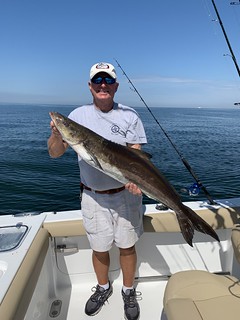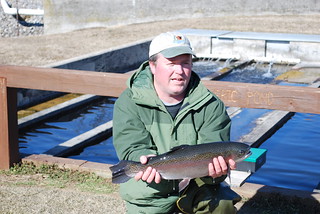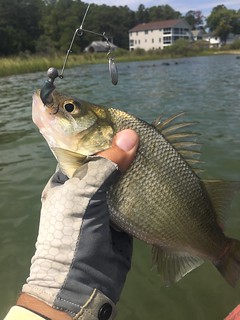Maryland Fishing Report – Sept. 18
The change of seasons is always a push-and-pull affair – recently it seemed that summer was just not ready to let go. This is a wonderful time of the year to still enjoy the outdoor activities Maryland’s warm weather affords, and is perhaps the best time of the year to enjoy large and heavy crabs as they fatten up for a winter’s rest — don’t miss it.
Forecast Summary: Sept. 18 – Sept. 24:
Windy, cool weather on Wednesday and Thursday will help mix more oxygen into the deeper waters of the Chesapeake Bay, expanding areas for fish. After Thursday, conditions will stabilize with warm, calm days and cool nights. The recent absence of rain has helped bring Bay salinities much closer to normal, allowing some of the more salt-loving fish to push further north. In general, Bay gamefish will still hold at similar locations but improved oxygen conditions will allow them to move deeper to find food. During the day, while the smaller fish will be abundant in surface waters, focus on the deeper, cooler waters that still have adequate oxygen for larger gamefish. As surface waters cool overnight, check nearby shoal areas at first light for larger striped bass hunting for breakfast.
Bay surface salinities are still below normal for this time of year but continue to increase from last month. Current oxygen conditions will be improving, but for now the ”Don’t fish below this depth” lines are as follows: from the Virginia state line north to Point No Point, 45 feet; Point No Point up to Little Choptank, 32 feet; Little Choptank up to the Choptank River, 25 feet; Bloody Point, 16 feet; Bay Bridge, 23 feet; Swan Point, 17 feet; Still Pond, 23 feet; and up to the Susquehanna Flats; to the bottom.
Expect reduced water clarity from algal blooms on the mainstem of the Bay from Patapsco River across to the Chester River and down to the Bay Bridge. Blooms are also present on the mouth of the Choptank River. On the Potomac River, a heavy algal bloom is present from the mouth of the Wicomico down to Ragged Point. To see the latest NOAA satellite maps, check “Eyes on the Bay Satellite Maps.”
Bay water temperatures are holding at 77 degrees. Water temperatures at Little Falls have dropped to 79 degrees. Expect normal flows from most of Maryland’s rivers and streams this week. There will be above average tidal currents through Friday as a result of last weekend’s full moon.
For the full weekly fishing conditions summary and more detailed and up-to-date fishing conditions in your area of the bay, be sure to check out Click Before You Cast. You can now get regular updates on Maryland’s waters and the creatures that call them home sent to your inbox with our new Eyes on the Bay newsletter. Sign up online.
The Conowingo Dam pool is providing some early morning striped bass action for those casting topwater lures. It pays to wear waders and cast as far as you can near the turbine discharges. The striped bass tend to be sub-legal but the action is fun and some larger fish in the mix make it all the more exciting. There is also early morning topwater striped bass action farther down the Susquehanna River and along the edges of the flats.
The striped bass action of June and July has lost some of its luster, as the fish are not so concentrated at places like Love Point and the Bay Bridge. Places like Pooles Island, Hodges Bar, the Key Bridge, and various knolls and shoal areas in the upper bay are holding fish on any given day. It will take some exploring to find them, but when you do they are responding to live lining spot, eels, small white perch, or jigging. The throwback ratio is substantial so take care when releasing. There continues to be limited action at the east side of the Bay Bridge for those jigging or live lining this week.
Anglers are reminded that they must use circle hooks when live lining. Check our website and video for more information on circle hooks and careful release. Also remember that water temperatures are still above 75 degrees, so sub-legal fish need to be released as quickly as possible with minimal handling stress to the fish. Do not hold the fish with a rag or towel, as this will rub off the protective slime layer of the striped bass.
Trolling a mix of spoons, red hoses and bucktails is a more viable method of fishing for striped bass as the fish are spread out along channel edges and various knolls in the upper bay. Jigging is also productive when suspended fish can be spotted. There are some breaking fish being spotted but usually these groups are made up of 14-inch to 16-inch striped bass.
Fishing for white perch is a great way to enjoy some fun fishing in the tidal rivers and creeks or out on the bay. When fishing deeper waters, a bottom rig baited with pieces of bloodworm or grass shrimp is hard to beat; dropper rigs with small jigs can work well also. The Kent Island party boats have been fishing in Kent Narrows at times and this area is a popular spot for those fishing from the bulkheads. Casting small spinnerbaits along shoreline structure offers fun fishing on light tackle.
Fishing for catfish offers a fun way to enjoy plenty of action. A mix of channel catfish and blue catfish can be found in the bay and the tidal rivers. Flathead catfish can be found in the lower Susquehanna River and surrounding areas. Use fresh cut bait — clam snouts work well.
Fishing for Spanish mackerel is offering some exciting action, whether you are trolling or casting to breaking fish. The mackerel are spread throughout the region but generally congregated along some of the steeper edges of the shipping channel. Bloody Point, Buoy 83, and south of the Choptank have been great places to troll or look for breaking fish on the east side of the bay. On the western side of the bay, there is plenty of action along the shipping channel edge from Chesapeake Beach south towards Cove Point. Those who are trolling are pulling small spoons behind No. 1 planers and various inline weights at about 8 knots. Spanish mackerel are real speedsters, so at that speed, you’ll avoid the small 12-inch to 14-inch striped bass that are spread throughout the region.
Keeping a steady eye on the horizon and using binoculars, one can spot diving sea gulls and breaking fish. Small striped bass are the largest contributor to the mayhem as they chase schools of bay anchovies; small bluefish are attracted to the feeding fest and Spanish mackerel will come zipping through at astonishing speeds. Pulling up at a reasonable upwind distance and drifting towards the melee is a good tactic that won’t spook the fish. Casting small but heavy spoons or similar metal into the fracas, allowing it to sink for about 5 seconds and reeling fast for all your worth, will attract the attention of the Spanish mackerel and keep lures away from the slower striped bass and bluefish.
On your depth finder, blips close to the bottom that resemble a submarine near the breaking fish or along channel edges can indicate large red drum. They are providing some exciting catch-and-release action this week for those jigging large spoons or soft plastic jigs.
Live-lining spot is the most popular way to fish for striped bass this week and Thomas Point Light continues to be the most popular place to fish. Striped bass are being caught on a regular basis but a considerable number are sub-legal. There is a sizable fleet present at most times so arrive early to anchor up in a good location.
Spot are readily available at most shallow hard bottom areas — Tolly Point, the shallow west side of Hacketts Point and the mouth of the Choptank River are just a few of the places spot can be found. Small pieces of bloodworm on a simple bottom rig work well and often white perch will be part of the mix.
Fishing for white perch in the middle bay region’s tidal rivers and creeks is very good. Fishing with bait such as grass shrimp or pieces of bloodworm from docks or piers is a great way to catch some fine eating perch. Keep in mind that the perch are usually holding to structure so dropping straight down next to the dock pilings is where the perch usually will be found. Casting small spinnerbaits or other small lures near shoreline structure with light tackle is also a fun way to catch white perch.

Retired lower bay charter captain Sonny Forrest recently made the trip from new home in the Florida Keys to fish his hometown waters, and holds up a nice cobia as his reward. Photo by Darren Rickwood
Fishing for Spanish mackerel could hardly be better this week, so don’t miss it. We are approaching the tail end of September and this mild weather and warm water temperatures will not last much longer. Trolling is perhaps the most popular way to fish for Spanish mackerel, with small spoons being pulled behind planers and inline weights at speeds around 8 knots or better.
Breaking fish consisting mostly of small striped bass and bluefish are chasing bay anchovies along the shipping channel edges and other channel areas — they have been attracting diving sea gulls which help give away locations. Spanish mackerel are flashing through the melee snapping up bay anchovies like swooping fighter jets. Casting small flashy metal lures into the center of the action, allowing the lure to sink for a five count and then speed reeling is a fun way to entice the Spanish mackerel to strike. Slower retrieves will allow the small striped bass and bluefish to catch up with the lure.
It is not uncommon for large red drum to be attracted to the action and they can be spotted on depth finders holding close to the bottom. Jigging with large spoons or soft plastic jigs is a great way to get in on some exciting catch and release action. Sometimes they can be found by spotting slicks or stirred up bottom in some of the shallower waters near the Middle Grounds or the Target Ship, or along channel edges.
Cobia are being seen swimming close to the surface by those watching from elevated positions with polaroid sunglasses — be ready with live eels or large soft plastic jigs. The eastern side near the Target Ship and Middle Grounds are great places to find them.
Live-lining for striped bass is mostly occurring near the Point Lookout area this week and anywhere suspended fish can be found along channel edges in the lower Potomac. There tends to be a fair percentage of sub-legal fish being caught but larger fish are being caught. The smaller striped bass are being seen far up the Potomac past the Route 301 Bridge.
Large numbers of spot are being found in the shallower areas of the lower Potomac and Patuxent rivers and Tangier and Pocomoke sounds. Most tend to be small but some larger ones are being caught along with a nice grade of white perch. Over on the eastern side of the bay speckled trout are entertaining fishermen along with some flounder action. There are of course large numbers of blue catfish to be caught in the Potomac, Patuxent and Nanticoke rivers.
This week presents some of the best opportunities for recreational crabbers to enjoy bountiful catches of large and heavy blue crabs. The best crabbing has been occurring in less than 10 feet of water, often in 6 feet or so. There tends to be a lot of small crabs and sooks in the mix so baits are being chewed up quickly.

Ken Booth holds up a nice trophy holdover rainbow trout that will put the shine on any trout fisherman’s day. Photo by Keith Lockwood
There are some fun times ahead for put-and-take trout fishermen as fall trout stocking begins in October. Trout hatchery managers have some exciting news for all of our trout anglers this year, as crews plan to stock approximately 26,000 rainbow trout, including the golden strain of rainbows. The average length will be from 12 inches to 15 inches, which equates to about ¾ pound to 1 pound each.
The department doesn’t provide an advance fall stocking schedule as seen in the spring, because the number of trout being stocked and the timing often are dictated by flow conditions and water temperatures. There is the possibility that water flows are not sufficient or water temperatures are too high for trout to survive at any given time. Once a stocking is completed at a site, the information is posted on the trout stocking website, or subscribers will be notified through our email news service. Lastly, anglers may also call 800-688-3467 to hear a recorded weekly update — usually updated on Fridays — once stocking begins.
Water temperatures are still warm enough that largemouth bass are feeding during the nighttime hours and retreating to deep cooler water or shade in slightly deeper waters during the day. Shade can be under thick grass mats, fallen treetops, bridge piers, or docks. Targeting shallow grass during the early morning and late evening hours is still the typical routine with various topwater lures. Fishing soft plastics or stick worms through the grass mats and grubs near deep sunken wood or structure works well during the day.
Crappie are a fun species to target near structure in some of the deeper waters of various freshwater impoundments and tidal rivers. Minnows and small jigs suspended under a slip bobber is the ticket to this fun action. Bluegills and other species of sunfish are active and will chase down small lures and flies or a simple worm or cricket under a bobber.
Surf fishermen are enjoying some good catches of kingfish this week, when using pieces of bloodworm on bottom rigs; spot and a few croaker can also be part of the mix. Those fishing with squid are catching a few flounder and blowfish. Those using cut bait of spot or mullet are catching small bluefish and sub-legal striped bass.
At the inlet and Route 50 Bridge area, bluefish continue to move in and out on the tides and are being caught by casting Got-Cha or metal lures, or drifting cut bait. Sub-legal striped bass are also part of the mix. Live lining spot has been popular to catch a mix of bluefish, striped bass and large flounder. In the back bay channels, flounder fishing has been good; there are a lot of sub-legal size fish so using larger baits is a good way to target the larger flounder.
Outside the inlet, there are plenty of small bluefish being caught at the shoal areas by those trolling small spoons behind planers or inline weights. A few Spanish mackerel are also part of the mix. Cobia are still cruising the general area and those able to sight-fish for them from flying bridges are casting live eels.
Sea bass fishing has been good this week with many reporting double-digit catches, along with a mix of flounder and triggerfish. Those heading out to the canyons are enjoying mild sea conditions this week and plenty of white marlin releases. Limits of dolphin have been common; some large yellowfin tuna are being caught along with a mix of wahoo, golden tilefish and an occasional blue marlin.
“You will find angling to be like the virtue of humanity, which has a calmness of spirit and a world of blessing attending upon it.” — Izaak Walton
Maryland Fishing Report is written and compiled by Keith Lockwood, Maryland Department of Natural Resources fisheries biologist.
Click Before You Cast is written by Tidewater Ecosystem Assessment Director Tom Parham.
This report is now available on your Amazon Echo device — just ask Alexa to “open Maryland Fishing Report.”




 1-888-373-7888
1-888-373-7888 233733
233733